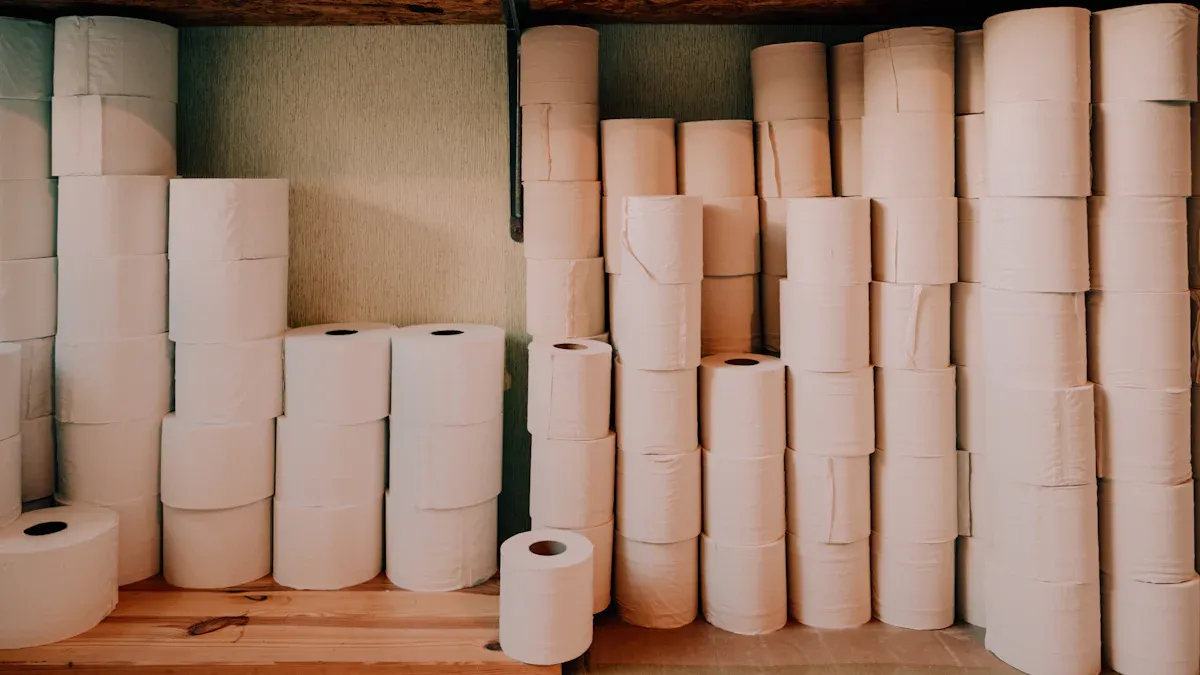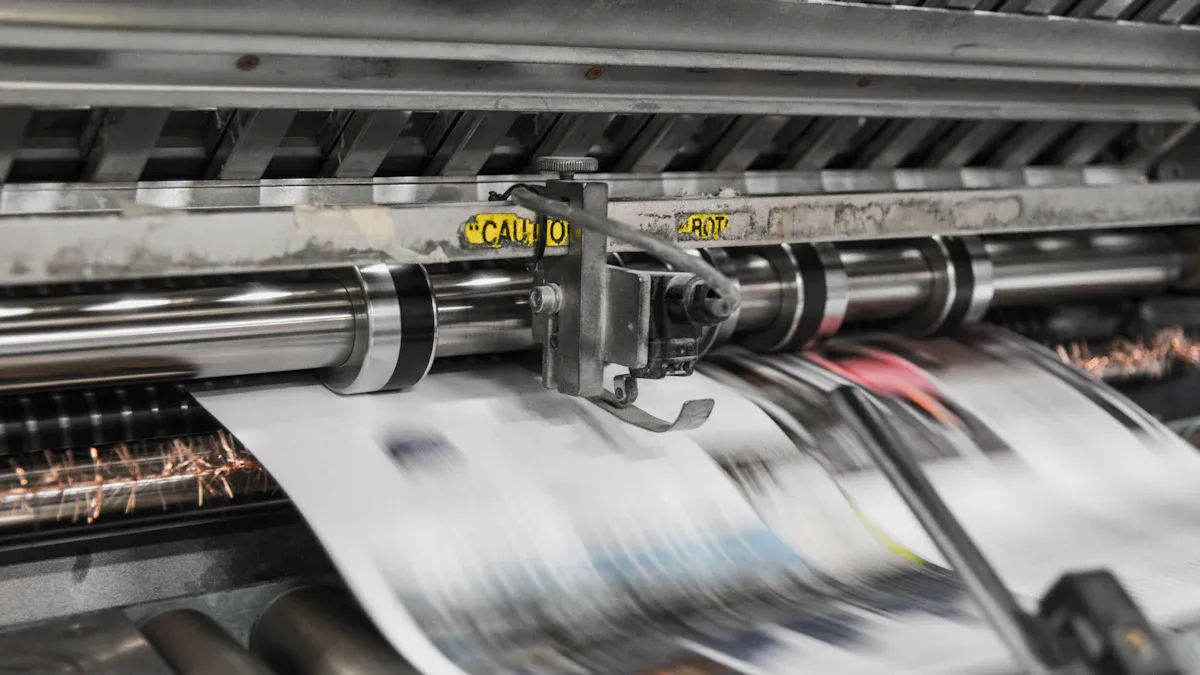
Bamboo offers an exceptional balance of softness, durability, and sustainability, making it a top choice for Paper Tissue Mother Reels. Virgin pulp delivers premium quality, ideal for high-end applications. Recycled paper appeals to eco-conscious buyers seeking cost-effective solutions. Manufacturers often process these materials into Tissue Jumbo Roll Paper or Customized Tissue Paper Mother Roll products. Additionally, raw material jumbo tissue paper ensures flexibility for diverse production needs.
Materials Used in Paper Tissue Mother Reels

Virgin Pulp
Virgin pulp is derived directly from wood fibers, offering unmatched purity and quality. This material is ideal for premium-grade paper tissue mother reels, as it provides exceptional softness and strength. Manufacturers often prefer virgin pulp for high-end applications where product performance is critical. However, the production process requires significant natural resources, which can impact its environmental footprint.
The performance of virgin pulp can be enhanced through processes like embossing and lamination. Embossing improves bulk and liquid absorption, while lamination enhances smoothness. These techniques ensure virgin pulp-based tissues meet the highest standards of quality and functionality.
Recycled Paper
Recycled paper is an eco-friendly alternative that appeals to environmentally conscious manufacturers and buyers. It uses post-consumer waste, reducing the need for virgin materials. This approach conserves energy, water, and natural resources. For instance:
- Producing one ton of recycled paper saves 4,100 kWh of power and 26,500 liters of water.
- It reduces landfill use by 3.1 m³ and prevents the cutting of 17 trees.
- The process generates 74% less air pollution compared to virgin pulp production.
Despite its environmental benefits, recycled paper may lack the softness and durability of virgin pulp. However, it remains a cost-effective choice for budget-conscious buyers.
Bamboo
Bamboo has emerged as a sustainable and versatile material for paper tissue mother reels. It offers a unique balance of softness and strength, outperforming many hardwood-based options. Bamboo paper is skin-friendly and breathable, making it suitable for sensitive skin. Unlike recycled paper, it avoids harmful chemicals, ensuring safety and comfort.
Bamboo’s rapid growth and minimal resource requirements make it an environmentally responsible choice. Its durability and softness make it a preferred material for manufacturers seeking high-quality yet sustainable solutions.
Comparing Materials for Paper Tissue Mother Reels
Softness
Softness plays a crucial role in determining the comfort and usability of paper tissue mother reels. Virgin pulp excels in this category due to its pure wood fibers, which create a smooth and luxurious texture. This makes it ideal for premium applications, such as facial tissues and high-end toilet paper. Bamboo also offers impressive softness, often rivaling virgin pulp. Its natural fibers are gentle on the skin, making it suitable for sensitive users. Recycled paper, while eco-friendly, tends to be less soft due to the processing of post-consumer waste. Manufacturers often enhance its texture through techniques like embossing, but it may still fall short compared to virgin pulp and bamboo.
Strength and Durability
Strength and durability are essential for ensuring the functionality of paper tissue mother reels. Bamboo stands out in this category, offering a unique combination of toughness and flexibility. Its fibers resist tearing, making it a reliable choice for multi-ply tissue products. Virgin pulp also provides excellent strength, particularly when processed for high-end applications. Recycled paper, while cost-effective, may lack the durability of bamboo and virgin pulp. However, it remains a viable option for single-ply tissues or products where strength is less critical.
Environmental Impact
The environmental impact of materials used in paper tissue mother reels varies significantly. Bamboo emerges as the most sustainable option. It grows rapidly and can be harvested without killing the plant, reducing soil erosion during harvesting. Virgin pulp, on the other hand, has a substantial environmental footprint. Over 270,000 trees are felled daily for paper pulp, with 27,000 trees specifically for toilet paper production. Recycled paper offers a more eco-friendly alternative, as it utilizes post-consumer waste and reduces the need for virgin materials. However, only 10% of felled trees contribute to manufacturing waste paper products.
| Material | Statistic |
|---|---|
| Bamboo | Can be harvested without killing the plant, reducing soil erosion during harvesting. |
| Virgin Pulp | Over 270,000 trees are felled every day for paper pulp, with 27,000 trees for toilet paper. |
| Recycled Paper | 10% of felled trees contribute to manufacturing waste paper products. |
Cost-Effectiveness
Cost-effectiveness is a key consideration for manufacturers and buyers of paper tissue mother reels. Bamboo offers a competitive edge, with 45% lower carbon emissions than recycled paper and 24% lower emissions than UK-made virgin pulp paper. This makes it an economical choice for eco-conscious buyers. Virgin pulp, while delivering premium quality, often comes at a higher cost due to its resource-intensive production process. Recycled paper remains the most budget-friendly option, appealing to manufacturers seeking cost savings without compromising environmental responsibility.
- Bamboo toilet paper has 45% lower carbon emissions than recycled paper.
- Bamboo toilet paper has 24% lower carbon emissions than UK-made virgin pulp paper.
The Role of Ply in Paper Tissue Mother Reels

Understanding Ply and Its Importance
Ply refers to the number of layers in paper tissue mother reels, which directly impacts the product’s softness, strength, and absorption capacity. Manufacturers often prioritize ply configurations to meet specific consumer needs. Single-ply tissues are lightweight and cost-effective, while multi-ply tissues offer enhanced durability and absorption.
Research highlights the significance of ply arrangement in determining product performance. Studies on 5-ply toilet paper reveal that stacking sequences influence mechanical properties and water absorption. Configurations involving 2-ply and 3-ply reels demonstrate notable increases in bulk and absorption capacity, underscoring the importance of ply numbers in achieving optimal durability.
Best Materials for Single-Ply Reels
Single-ply paper tissue mother reels require materials that balance cost-effectiveness and quality. Virgin wood pulp emerges as the preferred choice due to its purity and health safety. Made from 100% virgin wood chips, it ensures high-quality tissue products suitable for sensitive applications.
Recycled pulp, while eco-friendly, may compromise quality and pose health risks. Its derivation from waste paper introduces variability in texture and durability. Advanced production technologies, such as Through-Air-Dried (TAD) processes, enhance the performance of single-ply tissues, making virgin wood pulp the ideal candidate for this configuration.
Best Materials for Multi-Ply Reels
Multi-ply paper tissue mother reels demand materials with superior strength and absorption capabilities. Bamboo stands out as an excellent option due to its natural durability and flexibility. Its fibers resist tearing, making it suitable for multi-ply configurations that require robust performance.
Virgin pulp also performs well in multi-ply applications, offering exceptional softness and strength. Studies show that embossing processes significantly increase bulk and water absorption capacity, further enhancing the functionality of multi-ply tissues. Recycled paper, while less durable, remains a viable option for budget-conscious manufacturers seeking eco-friendly solutions.
Statistical data supports the importance of ply in multi-ply reels. Porosity tests reveal high levels of absorption across different materials, correlating with water absorption times. Bulk increases due to embossing processes further improve the performance of multi-ply tissues, making bamboo and virgin pulp the top choices for this configuration.
Practical Tips for Choosing Paper Tissue Mother Reels
Bamboo excels as the most sustainable material for paper tissue mother reels. Its softness, durability, and eco-friendly properties make it a top choice. Virgin pulp delivers premium quality but demands higher costs and resources. Recycled paper offers affordability and environmental benefits, though it lacks softness and strength.
Choosing the ideal material depends on balancing cost, quality, and environmental priorities.
FAQ
What is the most sustainable material for paper tissue mother reels?
Bamboo is the most sustainable option. It grows rapidly, requires minimal resources, and can be harvested without harming the plant, making it an eco-friendly choice.
How does ply affect tissue paper quality?
Ply determines softness, strength, and absorption. Multi-ply tissues offer enhanced durability and absorption, while single-ply tissues are lightweight and cost-effective for specific applications.
Can recycled paper match the quality of virgin pulp?
Recycled paper offers cost and environmental benefits but lacks the softness and durability of virgin pulp. Advanced processing techniques can improve its texture and performance.
Post time: Jun-04-2025
